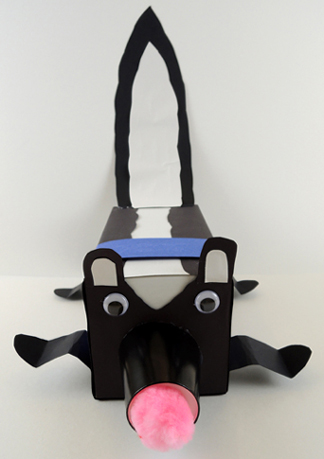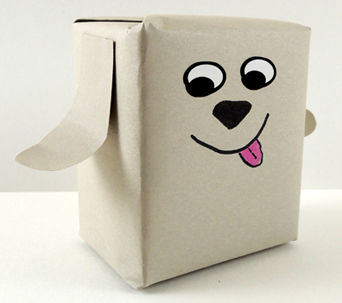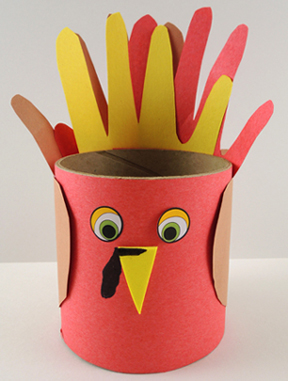
Become a dynamic crime-busting duo that thwarts theft and keeps the peace! JUST DON”T STARTLE OFFICER SKUNK.
We read Please Don’t Upset P.U. Zorilla by Lynn Rowe Reed (Alfred A. Knopf, 2006). When Mayor Tootlebee receives a letter from a well-mannered skunk named P.U. Zorilla, he immediately offers him a job. Unfortunately, the town quickly learns that no matter what the job – school bus driver, pet store clerk, ball park popcorn seller – something always happens that upsets P.U. Zorilla. And…well you can guess what happens next! However, when crime strikes at a local jewelry store, P.U. Zorilla manages to save the day, earning him a new job as Chief of Police!
You’ll need:
- 1 large tissue box
- Black and white construction paper
- 1 paper cup
- Dark blue poster board
- Crime fighting game (more on this below!)
- Scissors, tape and/or glue for construction
- Hot glue
The skunk is basically a large tissue box decorated with black and white paper. The nose is a paper cup, cut down to 2.5″ and attached with hot glue. We also added a jumbo pom-pom nose and wiggle eyes, but you can simply draw these on with markers.
 The books hilariously builds up to P.U. Zorilla inevitably doing what skunks do. We wanted to capture some of that fun, so our skunk box actually “sprays” when startled, courtesy of a rectangle cut in its rear and a white plastic grocery bag…
The books hilariously builds up to P.U. Zorilla inevitably doing what skunks do. We wanted to capture some of that fun, so our skunk box actually “sprays” when startled, courtesy of a rectangle cut in its rear and a white plastic grocery bag…
 Also part of the story time project? A police hat for you, and a police collar for your skunk. The hat is from our You’ve Got Mail post – we just swapped the red headband for a black one. Your skunk gets a blue construction paper collar as well. Notice the gold foil seals on the hat and collar? Kids earned those in the “Crime Fighting” portion of our story time:
Also part of the story time project? A police hat for you, and a police collar for your skunk. The hat is from our You’ve Got Mail post – we just swapped the red headband for a black one. Your skunk gets a blue construction paper collar as well. Notice the gold foil seals on the hat and collar? Kids earned those in the “Crime Fighting” portion of our story time:
 Katie printed 6 images on 8.5″ x 11″ card stock. Half of the images were calm (flowers, puppies, ice cream truck) and the other half were alarming (robber, loud noise, ghost). Katie walked the kids through the training, asking them to react to the different scenes. If it was alarming, the kids pulled the plastic bag out of their skunks and sprayed!
Katie printed 6 images on 8.5″ x 11″ card stock. Half of the images were calm (flowers, puppies, ice cream truck) and the other half were alarming (robber, loud noise, ghost). Katie walked the kids through the training, asking them to react to the different scenes. If it was alarming, the kids pulled the plastic bag out of their skunks and sprayed!


 The kit provides the basic pieces to get started. Namely an instructional booklet, 2 pipe cleaners, crystal powder, a plastic narwhal figurine, and a little paper backdrop to pose the finished product on.
The kit provides the basic pieces to get started. Namely an instructional booklet, 2 pipe cleaners, crystal powder, a plastic narwhal figurine, and a little paper backdrop to pose the finished product on. However, you will have to fill in some gaps with items you may or may not have already at home: 2 heatproof glass jars with lids (I used old jelly jars, but Bell jars would totally work), measuring cups and spoons, a plastic plate, and a pot holder or trivet. Most importantly, you need to use distilled water to make the crystal growing solutions. I bought a gallon of distilled water at the grocery store for 99 cents.
However, you will have to fill in some gaps with items you may or may not have already at home: 2 heatproof glass jars with lids (I used old jelly jars, but Bell jars would totally work), measuring cups and spoons, a plastic plate, and a pot holder or trivet. Most importantly, you need to use distilled water to make the crystal growing solutions. I bought a gallon of distilled water at the grocery store for 99 cents. Next, you make a crystal “growing solution” and let the narwhal soak in the solution for 4-8 hours. If you made the solution correctly, crystals will grow on the pipe cleaners. Let the narwhal dry overnight, then do a second round of soaking in the growing solution. If your experiment worked, you finish with a beautiful narwhal with a crystal tusk, water spout and tail!
Next, you make a crystal “growing solution” and let the narwhal soak in the solution for 4-8 hours. If you made the solution correctly, crystals will grow on the pipe cleaners. Let the narwhal dry overnight, then do a second round of soaking in the growing solution. If your experiment worked, you finish with a beautiful narwhal with a crystal tusk, water spout and tail! One suggestion…I had to get a bit creative with my glass jar because there wasn’t enough growing solution liquid to fully cover my narwhal. I simply rolled up a dish towel and rested my jar at an angle so the pipe cleaners were submerged.
One suggestion…I had to get a bit creative with my glass jar because there wasn’t enough growing solution liquid to fully cover my narwhal. I simply rolled up a dish towel and rested my jar at an angle so the pipe cleaners were submerged. Another suggestion is using something other than your fingers to remove the narwhal from the liquid after it is done soaking. I used a wood skewer, but you can also use a plastic spoon or tongs. In fact, every time I handled the narwhal or any of the experiment materials, I thoroughly washed my hands to remove residual crystal powder (which is aluminum potassium sulfate, or alum).
Another suggestion is using something other than your fingers to remove the narwhal from the liquid after it is done soaking. I used a wood skewer, but you can also use a plastic spoon or tongs. In fact, every time I handled the narwhal or any of the experiment materials, I thoroughly washed my hands to remove residual crystal powder (which is aluminum potassium sulfate, or alum). It took me 4 days to finish the project. But I allowed extra soaking time for the pom-pom “icebergs” to grow bigger crystals, so technically you can wrap up the experiment in 3 days. There is a great deal of adult supervision to complete this kit. I fully agree with the suggested age range of 8 and older with adult assistance. There is no way a child should work with stove tops, microwaves, boiling water, and chemicals without an adult present.
It took me 4 days to finish the project. But I allowed extra soaking time for the pom-pom “icebergs” to grow bigger crystals, so technically you can wrap up the experiment in 3 days. There is a great deal of adult supervision to complete this kit. I fully agree with the suggested age range of 8 and older with adult assistance. There is no way a child should work with stove tops, microwaves, boiling water, and chemicals without an adult present.







